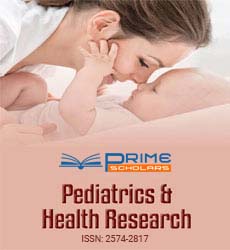Perspective - (2022) Volume 7, Issue 6
Epidemiology of Pediatric Trauma in the National Pediatric Trauma Registry Pilot Study and Pedunculated Lipofibroma in a Pediatric Patient
Mohammad Nafees*
Department of Science, University of California, USA
*Correspondence:
Mohammad Nafees,
Department of Science, University of California,
USA,
Tel: 8675412324,
Email:
Received: 31-Oct-2022, Manuscript No. IPPHR-22-15163;
Editor assigned: 02-Nov-2022, Pre QC No. IPPHR-22-15163 (PQ);
Reviewed: 16-Nov-2022, QC No. IPPHR-22-15163;
Revised: 21-Nov-2022, Manuscript No. IPPHR-22-15163 (R);
Published:
28-Nov-2022, DOI: 10.36648/2574-2817-7.6.55
INTRODUCTION
A thorough review of the literature was performed utilizing.
We focused on using meta-analysis from adult populations to
review current practices in interpretation and methodology
and find concordant pediatric studies to determine if the same
applications are validated in pediatric populations. Current evidence
supports the usage of procalcitonin as both a sensitive
and a specific marker for the differentiation of systemic inflammatory
response syndrome from sepsis in pediatrics with
increased diagnostic accuracy compared to commonly used
biomarkers including complete blood counts and C-reactive
protein. Although the body of evidence is limited, initial observations
suggest that procalcitonin can be used in pediatric
trauma and burn patients as both a prognostic and a diagnostic
marker, aiding in the identification of infection in patients with
extensive underlying inflammation.
Description
The authors report an atypical case of secondary syphilis in an
adolescent female presenting to a tertiary-care center with
fever, weight loss, oral sores, painful inguinal lymphadenopathy,
and transient macular rash. Given the lower prevalence of
syphilis in adolescent females, this infection was not included
on the initial differential diagnosis. The evolving presentation
of syphilis over time complicates the diagnosis and management
of these infections, as it did for the patient in this report.
The authors provide a detailed discussion of the patient’s clinical
findings, including the protean features of syphilis infection.
This case is particularly relevant to the fields of general
pediatrics and pediatric hospital medicine. The increasing scientific
information clearly demonstrates the important role of
inflammation in asthma. This evidence has led physicians to focus
their treatment on the elimination of inflammation instead
of working solely against bronchoconstriction. Steroids and
nonsteroidal agents are currently used to prevent this inflammatory
component. This paper focuses only on nonsteroidal
anti-inflammatory agents such as sodium cromoglycate, nedocromil
sodium and ketotifen and their use in pediatric asthma.
The discussion on each medication addresses its mechanism
of action, the evidence concerning its efficacy in pediatrics (ie,
clinical pharmacology, acute bronchial challenge, late asthmatic
response, bronchial hyperrcactivity, clinical efficacy) and the
pediatric dose.
Conclusion
While colorectal carcinoma is a common gastrointestinal
cancer in adults, it is rare in pediatrics with an incidence and
represents a fraction of neoplasms encountered in children.
Malignant neoplasms represent a major cause of mortality in
the pediatric age group. While presenting with weight loss,
iron deficiency, rectal bleeding, abdominal pain, and change in
bowel habits, or symptoms similar to acute appendicitis, the
working diagnosis may be considered to be anorexia. This case
illustrates the importance of considering colon cancer among
other disease entities as a cause of unintentional weight loss
in adolescents. While this is a rare occurrence in the pediatric
population, significant unintentional weight loss with altered
bowel habits should prompt a search for underlying malignancy
even in the absence of a positive family history or predisposing
cancer syndromes. The case of 38-month-old boy is being
reported who was brought to the pediatrics clinic with fever,
cough, hemoptysis, and breathing difficulty. Imaging studies
revealed a right lower chest mass. Lobectomy and histopathological
examination revealed it to be predominantly solid pleuropulmonary
blastoma type.
Citation: Nafees M (2022) Epidemiology of Pediatric Trauma in the National Pediatric Trauma Registry Pilot Study and Pedunculated Lipofibroma in a Pediatric Patient. Pediatr Heal Res. 7:55.
Copyright: © 2022 Nafees M. This is an open-access article distributed under the terms of the Creative Commons Attribution License, which permits unrestricted use, distribution, and reproduction in any medium, provided the original author and source are credited.
